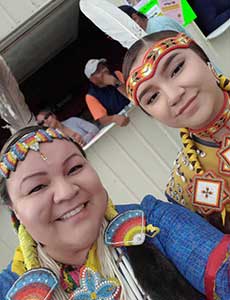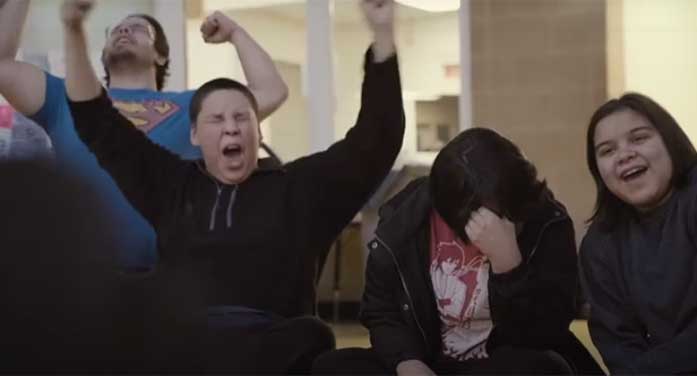How can volunteering for an after-school program help you finish high school, go to university and even get a job?
It’s all through the power of mentorship – having a role model and being one yourself. It promotes leadership skills, builds confidence, and fosters mino-bimaadiziwin (Anishinaabe) or mino-pimâtisiwin (Cree), which means “living in a good way.”
The Indigenous Youth Mentorship Program taps into that power for young people in five provinces, and now it will expand further thanks to a new Applied Public Health Chair grant of $1.5 million awarded by the federal government to Kate Storey, associate professor in the School of Public Health and Stollery Science Lab Distinguished Researcher.
“We know that educational attainment and employability are incredibly important as social determinants of health,” said Storey, whose work has helped to guide the program for the past six years.
IYMP supports high school students to run an after-school program for elementary school children, preparing healthy snacks, playing games and building relationships.
The little ones thrive under the attention of the older students, with school attendance going up on program days. But the biggest benefit is for the youth, who gain a sense of purpose and belonging, a sense of pride in their culture and skills that set them up for success.
Lisa Spence got involved as a student at R.B. Russell Vocational High School in the north end of Winnipeg. At 16, Spence was painfully shy and had no particular plans for post-secondary education and no idea what career path she would take. While she knew she was Indigenous, she was adopted and didn’t really know much about her heritage.
Public speaking and leadership weren’t skills Spence thought she had, or had even tried, but she soon found she had a real knack for working as part of a team. She loved the training she got from older university students. She met Elders and learned Indigenous games and traditions. When the little kids would meet her on the bus or street and treat her like a rock star, she was hooked.
“Being able to see that I made a little bit of a difference in the early years students, that just felt really great,” Spence said.
Since then, Spence has taken post-secondary training at Red River College and found her calling working with kids. At 28, she runs the program for the entire city of Winnipeg, with 10 staff, four high schools and 50 high school students participating. The young mentors remind her of how far she has come.
“It’s just really great to have a safe space for these youth to be able to learn and make mistakes and not be judged,” Spence said. “It’s like a very big circle where everybody has different things to teach and learn from each other.”
In Winnipeg, where IYMP began (it’s called Rec and Read there), the student mentors get high school credits for volunteering. They also get help with resume writing, free fees to apply for post-secondary courses, and bursaries.

Andrea Dion with daughter Cadence
Storey estimates the program has a direct cost of $13,500 to start in each community, spent on everything from snacks to equipment to transportation, depending on local needs. With the new research grant, she will calculate its social return on investment, consult with young people about their educational and employment aspirations, and co-create a high school course that can be used nationwide.
Andrea Dion, health and wellness consultant for Ever Active Schools (a national charity and implementation partner for IYMP) and member of the Samson Cree Nation, helps run IYMP in 33 Alberta First Nations communities.
“There’s so many more hurdles that we get, as Indigenous individuals, especially our youth on reserve, compared with the general population, including poverty, food security issues, domestic violence, lack of housing, even just access to fresh water,” she said.
Dion said the young mentors pick up many skills that can be transferred to other work or school settings – planning, budgeting, inventory management, public speaking, goal setting and evaluation, cooking skills and ahkameyiomok, the Cree value of perseverance.
She encourages IYMP mentors to shoot for the moon, even if that means leaving their communities for a while, but she also hopes they will rekindle what has nearly been lost in Indigenous communities over centuries of colonization.
“Go out, get the skills, live in that world, but come back and serve your community, because we need champions that are rooted and passionate about their own home,” she said.
Dion’s daughter, Cadence, was a mentor in Grade 11 at her high school IYMP program in Maskwacis and is now studying at the U of A, following in the footsteps of two previous generations of educators in her family and underscoring the value of role models.
Storey said she has benefited from mentorship as well, from IYMP’s Circle of Elders, staff and volunteers, and fellow academic champions. The national Applied Public Health Chairs have been awarded just three times and, each time, a University of Alberta School of Public Health researcher has been given one – Kim Raine for her research on children’s nutrition in 2012 and Candace Nykiforuk for her work on public health policy in 2014.
The Indigenous Youth Mentorship Program is made possible through support by the Stollery Children’s Hospital Foundation through the Women and Children’s Health Research Institute. Other supporters include the Canadian Institutes of Health Research, Public Health Agency of Canada, Diabetes Action Canada, Diabetes Canada, PolicyWise for Children & Families, Saskatchewan Health Research Foundation, the government of Alberta, Canadian Tire Jumpstart and the LEAP-Pecaut Centre for Social Impact.
| By Gillian Rutherford
Submitted by the University of Alberta’s Folio online magazine. The University of Alberta is a Troy Media Editorial Content Provider Partner.
© Troy Media
Troy Media is an editorial content provider to media outlets and its own hosted community news outlets across Canada.



